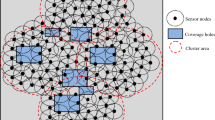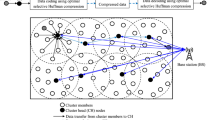Abstract
In the context of wireless sensor networks (WSNs), the study focuses on addressing coverage holes, representing areas where sensor nodes lack sufficient coverage due to factors such as node failure, energy depletion, or environmental obstacles. The research proposes an innovative approach utilizing advanced deep learning techniques to analyze and mitigate coverage holes in WSNs. The Improved Social Group Optimization (ISGO) algorithm quantifies coverage hole areas within the Region of Interest (RoI), offering insights for targeted patching. Subsequently, the Decentralized Game Optimization (DGO) algorithm is employed to precisely identify coverage hole boundaries, optimizing resource utilization for effective patching strategies. This research aims to enhance the reliability and comprehensiveness of monitoring in WSNs by addressing the challenges posed by coverage holes. Based on the identified coverage hole and its boundaries, we devise a comprehensive patching strategy to address the coverage deficiency. By strategically placing new sensor nodes within the RoI, we aim to fill the identified patch positions and ensure continuous coverage. The selection of these patch positions is guided by the revisiting graph neural network (RGNN), taking into consideration factors such as connectivity, energy efficiency, and overall network performance. To validate the effectiveness of proposed approach, we conduct extensive performance evaluations under various scenarios. By addressing coverage holes and deploying optimal patching strategies, our approach significantly improves the overall performance and efficiency of WSNs. The ISGO + DGO + RGNN technique presents substantial enhancements in coverage-hole detection and patching. Notably, it achieves significant reductions in hole detection time (87–99.6%), requires fewer patching sensors (56–70%), exhibits lower time complexity (26–83%), and shows decreased energy overhead (34–82%) compared to existing techniques. Moreover, the proposed technique consistently attains higher coverage rates (23–29%), affirming its superior efficiency and effectiveness in addressing the limitations of current methods for WSNs.



Similar content being viewed by others
Data Availability
Data are generated during simulations and are provided in this manuscript.
References
Egwuche, O.S., Singh, A., Ezugwu, A.E., Greeff, J., Olusanya, M.O., & Abualigah, L. (2023). Machine learning for coverage optimization in wireless sensor networks: A comprehensive review. Annals of Operations Research, 1–67.
Yan, X., Zhou, J., Huang, H., Wu, C., Sun, L., & Song, A. (2022). A weighted range-free localization algorithm for irregular multihop networks. International Journal of Communication Systems, 35(10), e5153.
Shene S.J., Emmanuel W.R.S., & Stephen, K.V.K. (2023). Review on energy conservation and congestion mechanism in mobile WSN: Taxonomy, software programs, challenges, and future trends. Wireless Networks, 1–21.
Mnasri, S., & Alghamdi, M. (2023). On the interest of Artificial Intelligence approaches in solving the IoT coverage problem. Ad Hoc Networks, 103321.
Ali, S., Li, Q., & Yousafzai, A. (2024). Blockchain and federated learning-based intrusion detection approaches for edge-enabled industrial IoT networks: A survey. Ad Hoc Networks, 152, 103320.
Angelin, A. C., & Silas, S. (2023). A comparative study of coverage hole detection techniques in wireless sensor networks. Engineering Proceedings, 59(1), 5.
Chowdhuri, R., & Barma, M.K.D. (2023). Node position estimation based on optimal clustering and detection of coverage hole in wireless sensor networks using hybrid deep reinforcement learning. The Journal of Supercomputing, 1–33.
Pravija Raj, P.V., Al Aghbari, Z., & Khedr, A.M. (2023). ETP-CED: Efficient trajectory planning method for coverage enhanced data collection in WSN. Wireless Networks, 1–16.
Gola, K. K., & Arya, S. (2023). Underwater acoustic sensor networks: Taxonomy on applications, architectures, localization methods, deployment techniques, routing techniques, and threats: A systematic review. Concurrency and Computation: Practice and Experience, 35(23), e7815.
Roshini, A., & Kiran, K. V. D. (2023). Hierarchical energy efficient secure routing protocol for optimal route selection in wireless body area networks. International Journal of Intelligent Networks, 4, 19–28.
Amiri, Z., Heidari, A., Navimipour, N. J., & Unal, M. (2023). Resilient and dependability management in distributed environments: A systematic and comprehensive literature review. Cluster Computing, 26(2), 1565–1600.
Liu, F., Ma, Z., Mu, B., Duan, C., Chen, R., Qin, Y., Pu, H., & Luo, J. (2023). Review on fault-tolerant control of unmanned underwater vehicles. Ocean Engineering, 285, 115471.
Cav, C., & Altın-Kayhan, A. (2023). Coverage hole optimization with a mobile sensor in wireless sensor networks for smart grid. Ad Hoc Networks, 140, 103039.
Al Aghbari, Z., Pravija Raj, P. V., & Khedr, A. M. (2023). A robust fault-tolerance scheme with coverage preservation for planar topology based wsn. Wireless Personal Communications, 129(3), 2011–2036.
Hallafi, A., Barati, A., & Barati, H. (2023). A distributed energy-efficient coverage holes detection and recovery method in wireless sensor networks using the grasshopper optimization algorithm. Journal of Ambient Intelligence and Humanized Computing, 14(10), 13697–13711.
Bozkaya, E., Karatas, M., & Eriskin, L. (2023). Heterogeneous wireless sensor networks: Deployment strategies and coverage models. In Comprehensive Guide to Heterogeneous Networks (pp. 1–32). Academic Press.
Nematzadeh, S., Torkamanian-Afshar, M., Seyyedabbasi, A., & Kiani, F. (2023). Maximizing coverage and maintaining connectivity in WSN and decentralized IoT: An efficient metaheuristic-based method for environment-aware node deployment. Neural Computing and Applications, 35(1), 611–641.
Sun, Q., Peng, X., Wang, X., Zhao, Z., Xu, J., Wang, L., Zhang, H., Yu, J. & Bai, Y. (2023). Optimal deployment for hybrid sensor networks based on efficient node configuration. International Journal of Intelligent Systems, 2023.
Cao, X., & Zhang, X. (2023). May. SaTCP: Link-layer informed TCP adaptation for highly dynamic LEO satellite networks. In IEEE INFOCOM 2023-IEEE Conference on Computer Communications (pp. 1–10). IEEE.
Khalifa, B., Al Aghbari, Z., & Khedr, A. M. (2023). CAPP: Coverage aware topology adaptive path planning algorithm for data collection in wireless sensor networks. Journal of Ambient Intelligence and Humanized Computing, 14(4), 4537–4549.
So-In, C., Nguyen, T. G., & Nguyen, N. G. (2019). An efficient coverage hole-healing algorithm for area-coverage improvements in mobile sensor networks. Peer-to-Peer Networking and Applications, 12, 541–552.
Vatankhah, A., & Babaie, S. (2018). An optimized bidding-based coverage improvement algorithm for hybrid wireless sensor networks. Computers & Electrical Engineering, 65, 1–17.
Singh, P., & Chen, Y. C. (2020). Sensing coverage hole identification and coverage hole healing methods for wireless sensor networks. Wireless Networks, 26, 2223–2239.
Yan, L., He, Y., & Huangfu, Z. (2020). A fish swarm inspired holes recovery algorithm for wireless sensor networks. International Journal of Wireless Information Networks, 27, 89–101.
Jain, J. K. (2020). A coherent approach for dynamic cluster-based routing and coverage hole detection and recovery in bi-layered WSN-IoT. Wireless Personal Communications, 114, 519–543.
Khelil, A., Beghdad, R., & Khelloufi, A. (2020). 3HA: Hybrid hole healing algorithm in a wireless sensor networks. Wireless Personal Communications, 112, 587–605.
Khalifa, B., Al Aghbari, Z., & Khedr, A. M. (2021). A distributed self-healing coverage hole detection and repair scheme for mobile wireless sensor networks. Sustainable Computing: Informatics and Systems, 30, 100428.
Robinson, Y. H., Lawrence, T. S., Julie, E. G., & Vimal, S. (2021). Development of fuzzy enabled coverage hole detection algorithm in wireless sensor networks. Wireless Personal Communications, 119, 3631–3649.
Chowdhury, A., & De, D. (2021). Energy-efficient coverage optimization in wireless sensor networks based on Voronoi-Glowworm Swarm Optimization-K-means algorithm. Ad Hoc Networks, 122, 102660.
Thirugnanasambandam, K., Raghav, R. S., Anguraj, D. K., Saravanan, D., & Janakiraman, S. (2021). Multi-objective binary reinforced cuckoo search algorithm for solving connected coverage target based WSN with critical targets. Wireless Personal Communications, 121(3), 2301–2325.
Sharma, P., & Singh, R. P. (2022). Coverage hole identification & healing in wireless underground sensor networks. Measurement: Sensors, 24, 100540.
Kumari, S., Mishra, P. K., Sangaiah, A. K., & Anand, V. (2023). Priority based k-coverage hole restoration and m-connectivity using whale optimization scheme for underwater wireless sensor networks. International Journal of Intelligent Networks, 4, 240–252.
Le Nguyen, P., Nguyen, K., Vu, H., & Ji, Y. (2019). Telpac: A time and energy efficient protocol for locating and patching coverage holes in wsns. Journal of Network and Computer Applications, 147, 102439.
Sharma, P., & Singh, R. P. (2022). Coverage hole identification & healing in wireless underground sensor networks. Measurement: Sensors, 24, 100540.
Yu, W. (2023). Distributed determination method of redundant nodes in wireless communication networks based on Bezier function. Wireless Networks, 1–12.
Lima, M. M., Sardinha, E. D., Balico, L. N., & Oliveira, H. A. (2023). PAtCH: Proactive approach to circumvent holes in wireless sensor networks. Sensors, 23(18), 7862.
Sivakumar, N. R., Nagarajan, S. M., Devarajan, G. G., Pullagura, L., & Mahapatra, R. P. (2023). Enhancing network lifespan in wireless sensor networks using deep learning based graph neural network. Physical Communication, 59, 102076.
Yao, J., Zhang, G., Kanno, J., & Selmic, R. (2009). Decentralized detection and patching of coverage holes in wireless sensor networks. In Intelligent Sensing, Situation Management, Impact Assessment, and Cyber-Sensing, 7352, 279–288. SPIE.
Zhai, S., Tang, Z., Wang, D., Li, Z., Chen, X., Fang, D., & Chen, F. (2017). Coverage hole detection and recovery in wireless sensor networks based on RSSI-based localization. In 2017 IEEE international conference on computational science and engineering (CSE) and IEEE international conference on embedded and ubiquitous computing (EUC), 2, 250–257. IEEE.
Aliouane, L., & Benchaiba, M. (2014). HACH: Healing algorithm of coverage hole in a wireless sensor network. In 2014 Eighth international conference on next generation mobile apps, services and technologies, 215–220. IEEE.
Wang, D., Tan, D., & Liu, L. (2018). Particle swarm optimization algorithm: An overview. Soft computing, 22, 387–408.
Funding
The authors declare that no funds, grants, or other support were received during the preparation of this manuscript.
Author information
Authors and Affiliations
Contributions
All authors contributed to the study conception and design. Data analysis was performed by both the authors. The manuscript was written by both the authors. Both authors read and approved the final manuscript.
Corresponding author
Ethics declarations
Competing Interests
The authors have no relevant financial or non-financial interests to disclose.
Additional information
Publisher's Note
Springer Nature remains neutral with regard to jurisdictional claims in published maps and institutional affiliations.
Rights and permissions
Springer Nature or its licensor (e.g. a society or other partner) holds exclusive rights to this article under a publishing agreement with the author(s) or other rightsholder(s); author self-archiving of the accepted manuscript version of this article is solely governed by the terms of such publishing agreement and applicable law.
About this article
Cite this article
Chowdhuri, R., Barma, M.K.D. Enhancing Network Reliability: Exploring Effective Strategies for Coverage-Hole Analysis and Patching in Wireless Sensor Networks. Wireless Pers Commun 134, 487–517 (2024). https://doi.org/10.1007/s11277-024-10933-7
Accepted:
Published:
Issue Date:
DOI: https://doi.org/10.1007/s11277-024-10933-7




